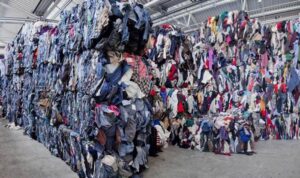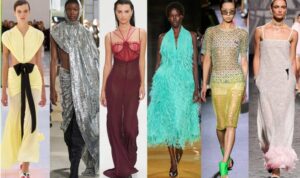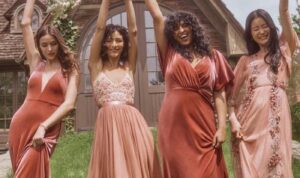Business casual outfits are all the rage, offering a perfect blend of professionalism and style. From defining the dress code to nailing the perfect ensemble, this guide has got you covered.
Get ready to upgrade your fashion game with the latest tips and trends in business casual attire.
Introduction to Business Casual Outfits
Business casual attire typically includes a mix of professional and comfortable clothing that is suitable for a workplace setting without being too formal. This can range from dress pants and blouses to polo shirts and khakis, allowing for a more relaxed and approachable look while still maintaining a level of professionalism.
In a business casual setting, dressing appropriately is crucial as it reflects your professionalism, respect for the workplace environment, and can even impact how others perceive you. It’s essential to strike the right balance between being too casual and too formal to ensure you are taken seriously and make a positive impression in the workplace.
The evolution of business casual dress codes in the workplace has shifted over the years, with many companies moving away from traditional business attire to a more relaxed and flexible dress code. This change has been influenced by factors such as a desire for a more inclusive and diverse workplace culture, as well as the rise of tech companies and startups that prioritize comfort and individual expression in their dress codes.
Elements of a Business Casual Outfit
When putting together a business casual outfit, there are key components that you need to consider to achieve the perfect balance between professional and relaxed style. From clothing items to accessories, each element plays a crucial role in creating a polished look suitable for a casual work environment.
Key Components of a Typical Business Casual Ensemble
- A well-fitted blazer or tailored jacket
- Dress pants or chinos
- Button-down shirts or blouses
- Polo shirts or sweaters
- Closed-toe shoes such as loafers or oxfords
Appropriate Colors, Fabrics, and Patterns for Business Casual Attire
- Colors: Stick to neutral tones like black, navy, gray, and beige. You can also incorporate subtle pops of color with accessories.
- Fabrics: Opt for breathable and comfortable fabrics like cotton, wool, and linen. Avoid overly casual materials like denim.
- Patterns: Choose classic patterns like stripes, checks, and subtle plaids. Avoid loud or bold patterns that can be distracting.
How Accessories Can Enhance a Business Casual Look
- Belts: A sleek leather belt can add a polished touch to your outfit and define your waistline.
- Watches: A stylish watch can elevate your look and showcase your attention to detail.
- Jewelry: Opt for minimal and understated pieces like stud earrings or a simple necklace to complement your outfit without overpowering it.
- Bags: Choose a structured tote or a sleek briefcase to carry your essentials in style.
Dress Codes and Guidelines
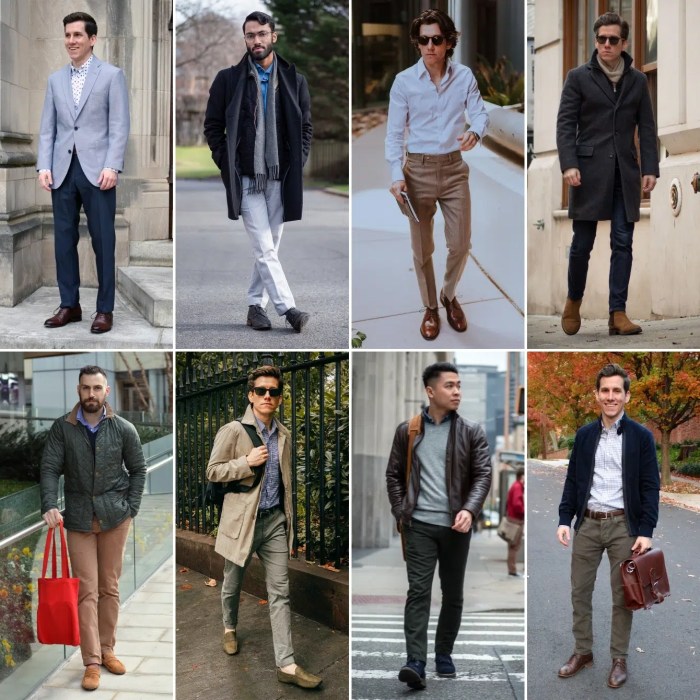
When it comes to business casual attire, it’s important to understand the different dress codes and guidelines to ensure you strike the right balance between professional and casual.
Common Dress Codes
- Business Casual: This dress code typically includes tailored pants or khakis, a button-down shirt, a belt, and closed-toe shoes. It allows for more casual elements like sweaters or blouses.
- Casual Fridays: Some workplaces have a casual Friday dress code, which may allow for jeans, sneakers, and more relaxed tops. However, it’s still important to maintain a level of professionalism.
- Smart Casual: This dress code is a step up from business casual and may include items like blazers, dressier shoes, and more polished accessories.
Do’s and Don’ts
- Do: Choose tailored pieces that fit well and flatter your body shape.
- Don’t: Wear clothing that is too tight, too revealing, or too casual (like sweatpants or graphic tees).
- Do: Pay attention to grooming and hygiene to maintain a polished look.
- Don’t: Forget about the importance of accessories – they can elevate your outfit and add a touch of personality.
Striking the Right Balance
When putting together a business casual outfit, it’s all about finding that sweet spot between professional and relaxed. One tip is to mix dressier pieces, like a blazer or dress pants, with more casual items, like a nice pair of loafers or a statement necklace. This way, you can show off your personal style while still looking put-together and ready for work.
Seasonal Considerations: Business Casual Outfits
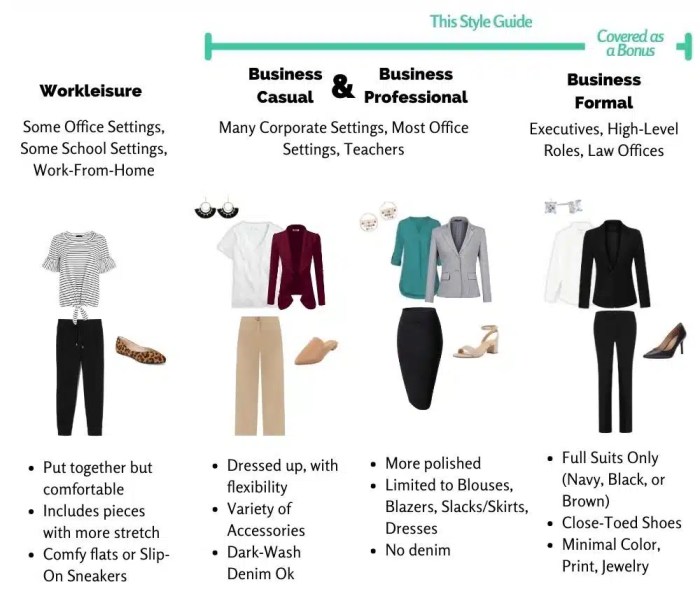
When it comes to business casual outfits, it’s important to consider the changing seasons and how they can affect your wardrobe choices. Adapting your outfits for different seasons will not only keep you comfortable but also ensure you look stylish and professional no matter the weather.
Adapting Business Casual Outfits for Different Seasons
- For warmer seasons like spring and summer, opt for lighter fabrics such as cotton and linen to stay cool. Consider wearing breathable blouses, lightweight trousers, and skirts in pastel colors or floral prints.
- In colder seasons like fall and winter, layering is key to staying warm while maintaining a business-appropriate look. Pair your outfit with a tailored blazer, cardigan, or sweater over a button-down shirt or blouse. You can also add tights or leggings under skirts or dresses for extra warmth.
Layering Techniques for Business Casual Attire in Colder Weather
- Layering not only adds warmth but also creates visual interest in your outfit. Start with a base layer such as a blouse or shirt, then add a sweater or cardigan, and finish with a blazer or coat. Make sure to mix different textures and colors for a stylish look.
- Don’t forget to pay attention to proportions when layering. Avoid bulky layers that can make you look shapeless. Opt for fitted pieces that flatter your figure and ensure a polished appearance.
Appropriate Footwear Choices for Each Season
- During warmer seasons, consider wearing open-toe heels, flats, or loafers for a chic and comfortable look. Sandals can also be appropriate in some business casual settings, but make sure they are not too casual or revealing.
- In colder seasons, opt for closed-toe shoes such as ankle boots, oxfords, or loafers to keep your feet warm and protected from the elements. Choose shoes in leather or suede for a polished finish that complements your winter outfits.
Business Casual for Different Occasions
When it comes to business casual attire, it’s essential to know how to tailor your outfit for specific events or meetings. The key is to strike the right balance between professional and relaxed, depending on the occasion.
Presentations
For presentations, opt for a well-fitted blazer paired with tailored trousers or a pencil skirt. Add a crisp button-down shirt or blouse and complete the look with closed-toe shoes. Avoid overly casual pieces like denim or sneakers to maintain a polished appearance.
Client Meetings
When meeting with clients, aim for a sophisticated yet approachable ensemble. Consider wearing a smart dress or a coordinated pantsuit with a silk blouse. Accessories should be minimal but elegant, such as a classic watch or simple jewelry. Make sure your shoes are clean and well-maintained to leave a positive impression.
Casual Fridays, Business casual outfits
On casual Fridays, you have more flexibility to incorporate casual elements into your outfit while still looking professional. You can opt for dark-wash jeans paired with a tailored blazer and a printed top. Loafers or dressy flats are suitable footwear choices for a comfortable yet stylish look.
Flexibility in Various Professional Settings
Business casual attire offers versatility in different professional settings, allowing you to adapt your outfit based on the company culture and the nature of the event. Whether attending a networking event, team meeting, or industry conference, you can mix and match pieces to create a suitable ensemble that conveys professionalism and style.
